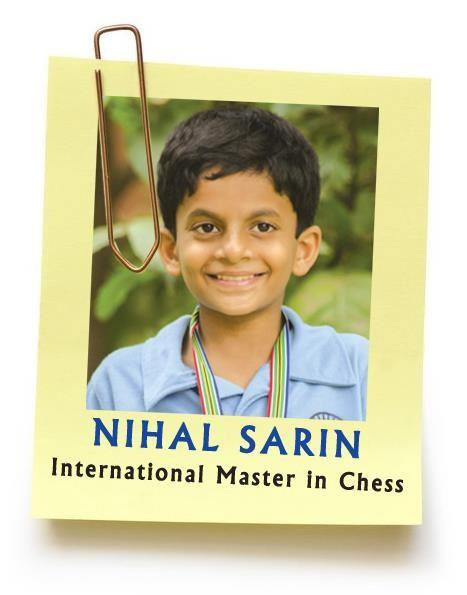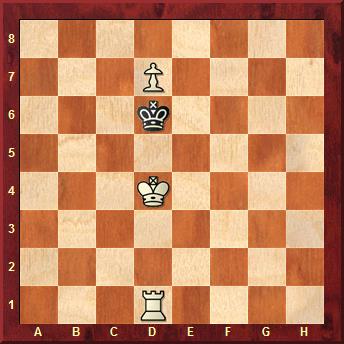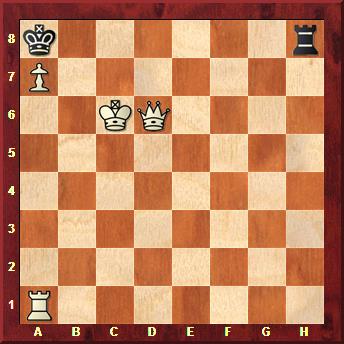 Nihal Sarin, born on 13 July 2004 Thrissur, Kerala (a southern state in India), learned chess at the age of five, advanced rapidly and earlier this year entered the record books by becoming an International Master at the tender age of 12 years and 08 months. His feat is reminiscent of the current world champion Magnus Carlsen of Norway, who had also become an IM at the age of 12 years and 08 months in 2003. Nihal is the second youngest International Master ever in India, and third youngest in the world. Last week he completed his first GM norm in Norway, crushing a 2600+ GM in the process.
Nihal Sarin, born on 13 July 2004 Thrissur, Kerala (a southern state in India), learned chess at the age of five, advanced rapidly and earlier this year entered the record books by becoming an International Master at the tender age of 12 years and 08 months. His feat is reminiscent of the current world champion Magnus Carlsen of Norway, who had also become an IM at the age of 12 years and 08 months in 2003. Nihal is the second youngest International Master ever in India, and third youngest in the world. Last week he completed his first GM norm in Norway, crushing a 2600+ GM in the process.
Just before the Norway tournament Nihal and his father Sarin visited Hamburg and spent some days at the ChessBase office, optimizing his computer and software, learning how to use the system more effectively. He also recorded a Playchess show with our endgame expert GM Dr Karsten Müller, which you can watch here in our video archives. It is an hour and a half of intense instructive analysis. I would not advocate missing it.
In the ChessBase office it was not all work and no play. Nihal is highly entertaining, blessed with a keen sense of humour, and always open to pranks. I want to describe some of his escapades in part two of this portrait.
What is the rule for pawn promotion, Nihal asked a number of chess players in the office. The usual answer was: When a pawn reaches the final rank of the board it can be promoted to any piece the player chooses. Then Nihal would give them a chess problem:

White to play and mate in three

This is 15-year-old German chess talent Luis Engel, rated 2362, who is doing an internship at ChessBase. At one stage Nihal asked him for the promotion rule and Luis gave it to him approximately the way we specified it above. Then he was confronted with the mate in three, which he (and everyone else in the office) could not solve. Can you, dear reader? Think about it for a while before you give up.
The solution – the only way for White to mate in three moves – is the devious move 1.d8K! White promotes the pawn to a second king and can now mate in two more moves: 1...Ke6 2.Rf1 Kd6 3.Rf6#. Ahh, so the rule was not correct: When a pawn reaches the final rank of the board it can be promoted to any piece except for a king! That is the correct way to put it.
Okay, if you have checked the above solution you are ready for the next problem:

White to play and mate in three

It looks fairly easy, and Luis immediately comes up with the solution: bishop to b2 (or c3, d4, etc., to relieve the stalemate), black pawn queens, king to g3 and 3.Qh2 mate. No, Nihal insists, the only correct solution is 1.Bf6! Why? Because after the other bishop moves Black plays the clever defence 1...a1P! i.e. the pawn is not promoted, and so 2.Kg3 doesn't work because it is still stalemate.
Incidentally, these problems were composed by Dr A. Krämer and published in the magazine Deutsche Schachblätter in 1949. Unfortunately we discovered a cook in the above position: the intended solution is 1.Bf6! a1P 2.Bh4 Kh2 3.Bxf2#, but White can also play 1.Kh3 on the first move and mate in three. Luis and the others did not see this line – the bishop move is so obvious.
So the trick and lesson worked, and the rule now says When a pawn reaches the final rank of the board it must be promoted to any piece, except for a king! Next problem:

Once again White to play and mate in three

This is Mathias Feist, ChessBase and chess engine programmer, chess trainer in his free time, a brilliant analytical mind. He went for 1.f8Q (followed by Kh7 and Qxh6 mate), but Nihal played 1...g2 and the line did not work. "Ahh, so 1.f8N!" said Mathias, "with Nh7 and Nf6 mate." No, because 1...Bf1 and 2...Rh2 allow the king to escape. So what to do? The Fritz programmer was at his wit's end.
Nihal's solution: 1.f8=?, i.e. you leave the pawn on f8. Mathias, who had been through the first two problems, said: "No, you have to promote the pawn, that was the rule we agreed on." Yes, but not necessarily on the same move! "Play your next move and then I'll decide which piece to take," said the lad. If Black plays 1...Bf1 White changes the pawn into a queen, if Black plays 1...g2 he takes a knight. Okay, Mathias said, you have to do it immediately.
So the correct rule is: when a pawn reaches the final rank you have to promote it, to any piece except for a king, on the same move, right? That leads to the final problem:

White to play and mate in two

This is André Schulz, who runs our German language news page, works for ChessBase Magazine and looks after our DVD authors, being duped by the 12-year-old. André had been taken through the three previous problems and had decided that the last definition was waterproof. But there is still a loophole, and he was stunned when Nihal showed him what we had missed.

The delight of the boy when he tells André the solution – which we do not show in the picture. I do not intend to give you at all, dear reader, and will be very upset if anyone posts it in the feedback section. Think about the problem for a while – the solution will suddenly occur to you, and make you smile. At the end of this article we are offering a special prize for readers who send in the correct solution.
Chess was not the only thing we fooled around with. One evening I gave Nihal my famous guillotine problem (which I published years ago, in our previous news page section). He was stumped and begged me to tell him the solution before he went to sleep. I did not, and the next day at breakfast I found that he had figured it out himself. Much more satisfying than getting it from Fred, isn't it? There were a number of other tricks and pranks while he stayed at my home, and also during an outing in the wild life park that is located just fifteen minutes away.

Mobbed by spotted deer in the wildlife park

That's enough, guys! Nihal confessed that he had never encountered animals at such close quarters before.

Feeding bats in the special dark house they have. Nihal thinks I am the bravest person on the planet for doing this. I think I have secured his lifelong admiration.

Oh, and the levitation we showed you in the previous article?

Of course it was all a trick, involving a trampoline and some judicious cropping
One more puzzle
During the wildlife park outing I had given Nihal my most infamous problem: "A game begins with 1.e4 and ends in the fifth move with knight takes rook mate". He had seen before but could not recall the solution. After finding "a hundred" NxR mates on move six he at last remembered (and could start looking at the animals again). As a revenge he gave me the following puzzle:
A game ends on move four with a b-pawn giving mate.
I must confess I did not have a clue, walking around without a chessboard or anything. In the evening I used a special engine – the human kind, since computer programs are of little use here. I gave the problem to Vladimir Kramnik, with whom I was chatting, and he found the solution in 33 minutes (yes, Vlady, Skype messages have time stamps!). He says he solved it while taking "a couple of calls in between". I believe him.

Anyway, this is a second problem for our readers to solve (and once again no moves in the feedback section, please!).
Send your solutions to both problems – the b-pawn mate and the last promotion puzzle – together with your comments on Nihal's chess pranks to our special puzzle feedback address (subject: Nihal problems).
From all messages we receive until April 30 we will draw a winner who gets an interesting prize: a Fritz 15 program, signed by three World Champions!


















 Nihal Sarin, born on 13 July 2004 Thrissur, Kerala (a southern state in India), learned chess at the age of five, advanced rapidly and earlier this year entered the record books by becoming an International Master at the tender age of 12 years and 08 months. His feat is reminiscent of the current world champion Magnus Carlsen of Norway, who had also become an IM at the age of 12 years and 08 months in 2003. Nihal is the second youngest International Master ever in India, and third youngest in the world. Last week he
Nihal Sarin, born on 13 July 2004 Thrissur, Kerala (a southern state in India), learned chess at the age of five, advanced rapidly and earlier this year entered the record books by becoming an International Master at the tender age of 12 years and 08 months. His feat is reminiscent of the current world champion Magnus Carlsen of Norway, who had also become an IM at the age of 12 years and 08 months in 2003. Nihal is the second youngest International Master ever in India, and third youngest in the world. Last week he 



















